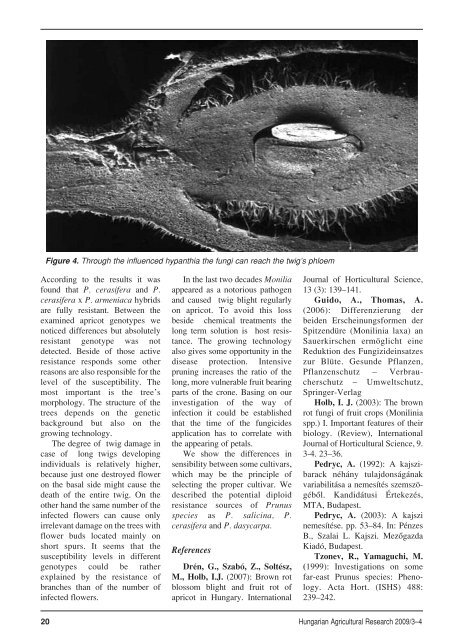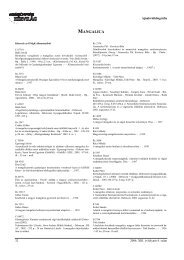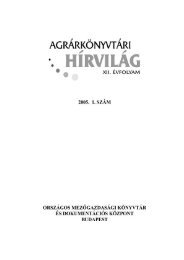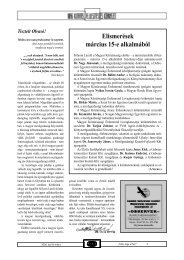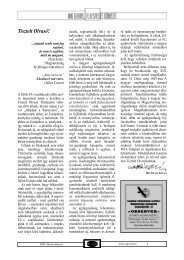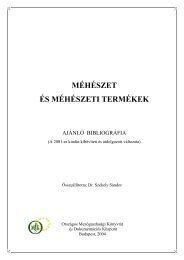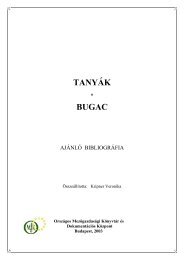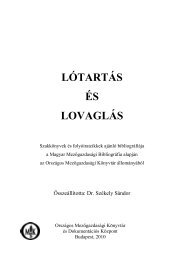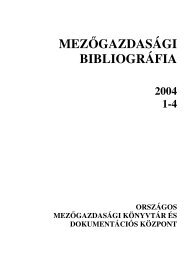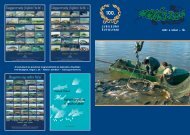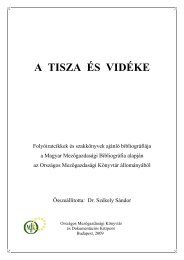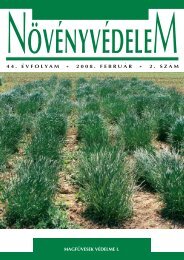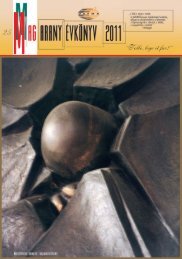hUNGARiAN AGRicUltURAl RESEARch
hUNGARiAN AGRicUltURAl RESEARch
hUNGARiAN AGRicUltURAl RESEARch
Create successful ePaper yourself
Turn your PDF publications into a flip-book with our unique Google optimized e-Paper software.
Figure 4. Through the influenced hypanthia the fungi can reach the twig’s phloem<br />
According to the results it was<br />
found that P. cerasifera and P.<br />
cerasifera x P. armeniaca hybrids<br />
are fully resistant. Between the<br />
examined apricot genotypes we<br />
noticed differences but absolutely<br />
resistant genotype was not<br />
detected. Beside of those active<br />
resistance responds some other<br />
reasons are also responsible for the<br />
level of the susceptibility. The<br />
most important is the tree’s<br />
morphology. The structure of the<br />
trees depends on the genetic<br />
background but also on the<br />
growing technology.<br />
The degree of twig damage in<br />
case of long twigs developing<br />
individuals is relatively higher,<br />
because just one destroyed flower<br />
on the basal side might cause the<br />
death of the entire twig. On the<br />
other hand the same number of the<br />
infected flowers can cause only<br />
irrelevant damage on the trees with<br />
flower buds located mainly on<br />
short spurs. It seems that the<br />
susceptibility levels in different<br />
genotypes could be rather<br />
explained by the resistance of<br />
branches than of the number of<br />
infected flowers.<br />
In the last two decades Monilia<br />
appeared as a notorious pathogen<br />
and caused twig blight regularly<br />
on apricot. To avoid this loss<br />
beside chemical treatments the<br />
long term solution is host resistance.<br />
The growing technology<br />
also gives some opportunity in the<br />
disease protection. Intensive<br />
pruning increases the ratio of the<br />
long, more vulnerable fruit bearing<br />
parts of the crone. Basing on our<br />
investigation of the way of<br />
infection it could be established<br />
that the time of the fungicides<br />
application has to correlate with<br />
the appearing of petals.<br />
We show the differences in<br />
sensibility between some cultivars,<br />
which may be the principle of<br />
selecting the proper cultivar. We<br />
described the potential diploid<br />
resistance sources of Prunus<br />
species as P. salicina, P.<br />
cerasifera and P. dasycarpa.<br />
References<br />
Drén, G., Szabó, Z., Soltész,<br />
M., Holb, I.J. (2007): Brown rot<br />
blossom blight and fruit rot of<br />
apricot in Hungary. International<br />
Journal of Horticultural Science,<br />
13 (3): 139–141.<br />
Guido, A., Thomas, A.<br />
(2006): Differenzierung der<br />
beiden Erscheinungsformen der<br />
Spitzendüre (Monilinia laxa) an<br />
Sauerkirschen ermöglicht eine<br />
Reduktion des Fungizideinsatzes<br />
zur Blüte. Gesunde Pflanzen,<br />
Pflanzenschutz – Verbraucherschutz<br />
– Umweltschutz,<br />
Springer-Verlag<br />
Holb, I. J. (2003): The brown<br />
rot fungi of fruit crops (Monilinia<br />
spp.) I. Important features of their<br />
biology. (Review), International<br />
Journal of Horticultural Science, 9.<br />
3-4. 23–36.<br />
Pedryc, A. (1992): A kajszibarack<br />
néhány tulajdonságának<br />
variabilitása a nemesítés szemszögébôl.<br />
Kandidátusi Értekezés,<br />
MTA, Budapest.<br />
Pedryc, A. (2003): A kajszi<br />
nemesítése. pp. 53–84. In: Pénzes<br />
B., Szalai L. Kajszi. Mezôgazda<br />
Kiadó, Budapest.<br />
Tzonev, R., Yamaguchi, M.<br />
(1999): Investigations on some<br />
far-east Prunus species: Phenology.<br />
Acta Hort. (ISHS) 488:<br />
239–242.<br />
20 Hungarian Agricultural Research 2009/3–4


